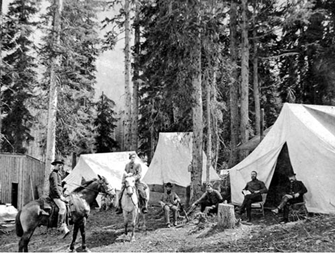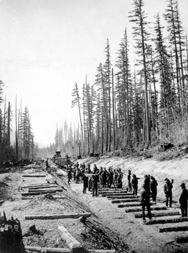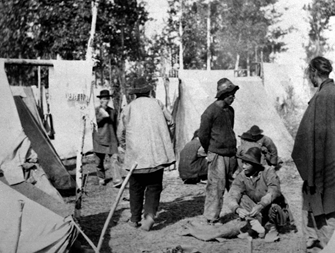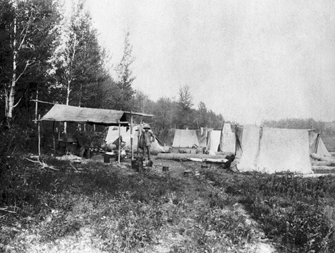"The route offers very serious obstacles ... in account of high precipices which have to be crossed and the general rocky nature of the country ..."
"They did not have hats, gloves, boots or any warm clothing. They were from southern China, a very warm area, and they were totally ill prepared."
"I don't know what he did for the railroad other than he survived it."
"We were told about separate camps where one camp was Chinese the other camp was white and how the pay wouldn’t include allowances for food or anything. So the meager amount they got they would have to use it to cover everything, whereas the white camps got much more."
April 13 - "A Chinese drilling on the ledge of a bluff near Alexandra Bar is
killed when a stone falls from above and knocks him off."
September 4 - "A Chinese killed by a rock slide."
September 11 - "A Chinese is smothered to death in an earth cave-in."
Working Conditions
After a long and difficult voyage across the Pacific Ocean, a short trip across the Georgia Strait to mainland British Columbia, and a boat ride up the Fraser River, the new arrivals disembarked at Yale where they would begin their work for the CPR. During the gold rush Yale was a prosperous town, but declined when the gold rush ended. It regained its prosperity during the time of the railroad construction. The town was the site of Onderdonk’s household and headquarters, and of a large camp that housed as many as a 1,000 workers. Other similar sized camps were located at Savona's Ferry and Port Moody.
The treacherous Fraser Canyon and Hell's Gate lay north of Yale, and the river beyond the town was impossible to navigate. The rest of the journey to the work sites was on foot. The Chinese were divided into groups of 30 men. Each group had a cook, an assistant cook, a Chinese record keeper who kept track of work hours and other details, and a white foreman or "herder" who dealt directly with the record keeper. Once the groups were formed they made their way to Lytton on uphill mountain trails with supplies suspended on shoulder poles or in large packs on their backs. Often holding onto a rope, they climbed in single file up the mountains to the work sites.
next page >Two sections of the railroad - Port Moody to Yale (145 km, 90 mi.) and Lytton to Savona’s Ferry - (113 km, 70 mi.) were built using primarily Chinese labour. Chinese, white and aboriginal labour worked on the section from North Bend to Lytton (42 km, 26 mi.), while mostly white labour worked on the section from Yale to North Bend (45 km, 27 mi.).
< previous pageChinese railroad workers were given the difficult and dangerous jobs. Using simple tools and manual labour, they built roadbeds, bridges and tunnels along a route that spanned deep canyons and rivers and cut through hard granite mountains. The work was backbreaking. They moved an unimaginable amount of rock and gravel in pushcarts, and on shoulder poles. Many died when explosives were used, through tunnel collapses and other accidents. Blasting was often done with cheaper nitroglycerine, rather than the more stable and expensive TNT dynamite, which the white workers used. Chinese worked under extreme conditions, sometimes clinging to the side of a steep mountainside or while suspended in the air by harnesses in the skeleton of a partially built bridge.
The bitterly cold mountain weather caused great hardship. Engineer Henry Cambie wrote in his log "Chinamen who are still at work appear to suffer dreadfully from cold. They work in overcoats and wrap their heads up in mufflers." Working from mid-November on was almost impossible for many men.
Despite the difficult work conditions and the weather, the Chinese men earned the reputation of being excellent workers. Michael Haney, Onderdonk’s superintendent, wrote that he could not recall even one incident of dishonesty. J.A. Chapleau, the Premier of Quebec, testified at The Royal Commission on Chinese Immigration in 1885 that the Chinese workers were "... trained gangs of rock men as good as I ever saw."
Very little is known about the personal experiences of the Chinese railroad workers and the living conditions in the railroad camps. There are few records, and those that do exist are written from the perspective of white people. Any personal letters or diaries that Chinese workers may have written have been lost. Few oral accounts have been passed down to descendants. However, a large number of photographs taken at the time give an idea of life in the camps.
Some of the camps were large and accommodated 1,000 men or more. The camps at Yale, Savona's Ferry and Port Moody reached this size at times. The camps had Chinese stores and services such as barbershops. Two men, Cheng Ging Butt and On Lee, opened general merchandise stores in Yale in the early 1880s and continued operating after the railroad was completed. There is some evidence that the camps included independent stores run by companies out of Victoria. In towns along the route, other Chinese run stores could be found.
The transient nature of the work may have been one of the reasons why Chinese workers did not organize unions, lodges or clan associations at the work sites, although they did exist in Victoria and Barkerville. However, on more than one occasion, workers organized strikes to protest unacceptable work conditions. In 1881, hundreds of workers marched into Yale armed with crowbars, shovels and pickaxes and attacked Onderdonk's headquarters over a 2% tax that was levied on the workers' wages.
Prosperity eluded those seeking the fortunes of "Gold Mountain" through railroad construction. A discriminatory wage system that paid Chinese workers less than white workers kept them impoverished. Chinese workers hoped to make enough money to achieve financial security if and when they returned to China. However, many who wanted to return were unable to save enough money for the passage back.
The wage of $1.00 a day or less that Onderdonk paid his Chinese workers was barely enough to survive on. As part of their contract, the Chinese workers were required to buy their supplies at CPR company stores where prices were inflated, further eating away at any possible savings. After paying for food, clothing, equipment and shelter, there was little money left over. Also, they were not paid over the three winter months when construction came to a standstill due to the weather. This further reduced their yearly income. At the end of the year, the average amount saved was about $43. Since many borrowed money for passage to Canada, the savings were often used to pay back the companies or agents that had lent them the money..
The low wages paid to Chinese workers kept the cost of building the railway down by twenty-five percent and kept Onderdonk from going bankrupt. It is estimated that he saved between $3 M and $5 M by using Chinese labour.
The exact number of Chinese men that died building the railroad is unknown. Their deaths were often omitted from accident reports issued by Onderdonk's company, while the deaths of white workers were recorded. Diary entries by Henry Cambie, the Canadian government engineer supervising the construction, and news reports of the time show that deaths were a regular occurrence. In February, 1883, the Inland Sentinel reports, "Here in British Columbia along the line of the railway, the China workmen are fast disappearing under the ground."
One conservative estimate of 600 deaths is based on Onderdonk's testimony at the 1885 Royal Commission on Chinese Immigration. Other estimates are in the thousands. Safety measures to protect Chinese workers from injury or death were non-existent. Many men died through accidents at work sites. Blasting, in particular, killed workers who were crushed by collapsing tunnels and rock slides. Illnesses caused by sub-standard living conditions and crippling winter weather also took the lives of men. Scurvy, a disease caused by a vitamin deficiency produced by eating a diet limited to rice and dried salmon, ran unchecked through the camps, killing hundreds.
next page >Neither Onderdonk nor the agents who arranged passage to Canada provided medical care to those who were ill. Families were often not notified when someone died, nor was compensation paid as promised by the agents. In 1891, the bones of more than 300 men from graves in the Thompson and Fraser canyons were collected by the Chinese Consolidated Benevolent Society and returned to China for burial.
< previous page









































